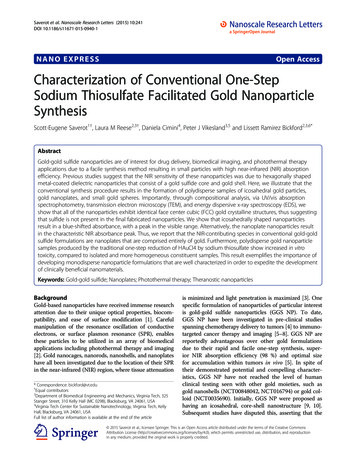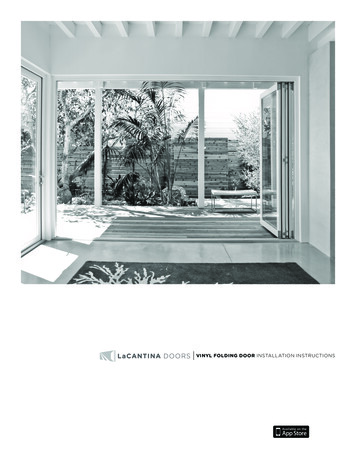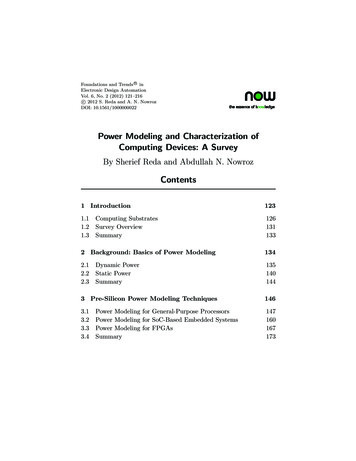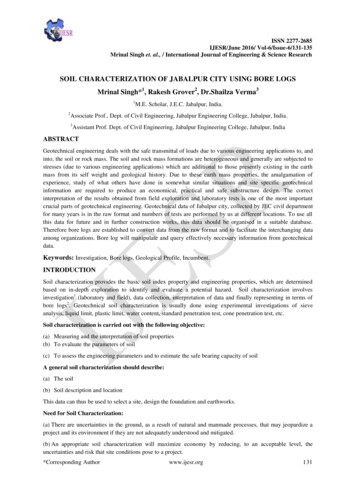
Transcription
Saverot et al. Nanoscale Research Letters (2015) 10:241DOI 10.1186/s11671-015-0940-1NANO EXPRESSOpen AccessCharacterization of Conventional One-StepSodium Thiosulfate Facilitated Gold NanoparticleSynthesisScott-Eugene Saverot1†, Laura M Reese2,3†, Daniela Cimini4, Peter J Vikesland3,5 and Lissett Ramirez Bickford2,3,6*AbstractGold-gold sulfide nanoparticles are of interest for drug delivery, biomedical imaging, and photothermal therapyapplications due to a facile synthesis method resulting in small particles with high near-infrared (NIR) absorptionefficiency. Previous studies suggest that the NIR sensitivity of these nanoparticles was due to hexagonally shapedmetal-coated dielectric nanoparticles that consist of a gold sulfide core and gold shell. Here, we illustrate that theconventional synthesis procedure results in the formation of polydisperse samples of icosahedral gold particles,gold nanoplates, and small gold spheres. Importantly, through compositional analysis, via UV/vis absorptionspectrophotometry, transmission electron microscopy (TEM), and energy dispersive x-ray spectroscopy (EDS), weshow that all of the nanoparticles exhibit identical face center cubic (FCC) gold crystalline structures, thus suggestingthat sulfide is not present in the final fabricated nanoparticles. We show that icosahedrally shaped nanoparticlesresult in a blue-shifted absorbance, with a peak in the visible range. Alternatively, the nanoplate nanoparticles resultin the characteristic NIR absorbance peak. Thus, we report that the NIR-contributing species in conventional gold-goldsulfide formulations are nanoplates that are comprised entirely of gold. Furthermore, polydisperse gold nanoparticlesamples produced by the traditional one-step reduction of HAuCl4 by sodium thiosulfate show increased in vitrotoxicity, compared to isolated and more homogeneous constituent samples. This result exemplifies the importance ofdeveloping monodisperse nanoparticle formulations that are well characterized in order to expedite the developmentof clinically beneficial nanomaterials.Keywords: Gold-gold sulfide; Nanoplates; Photothermal therapy; Theranostic nanoparticlesBackgroundGold-based nanoparticles have received immense researchattention due to their unique optical properties, biocompatibility, and ease of surface modification [1]. Carefulmanipulation of the resonance oscillation of conductiveelectrons, or surface plasmon resonance (SPR), enablesthese particles to be utilized in an array of biomedicalapplications including photothermal therapy and imaging[2]. Gold nanocages, nanorods, nanoshells, and nanoplateshave all been investigated due to the location of their SPRin the near-infrared (NIR) region, where tissue attenuation* Correspondence: bickford@vt.edu†Equal contributors2Department of Biomedical Engineering and Mechanics, Virginia Tech, 325Stanger Street, 310 Kelly Hall (MC 0298), Blacksburg, VA 24061, USA3Virginia Tech Center for Sustainable Nanotechnology, Virginia Tech, KellyHall, Blacksburg, VA 24061, USAFull list of author information is available at the end of the articleis minimized and light penetration is maximized [3]. Onespecific formulation of nanoparticles of particular interestis gold-gold sulfide nanoparticles (GGS NP). To date,GGS NP have been investigated in pre-clinical studiesspanning chemotherapy delivery to tumors [4] to immunotargeted cancer therapy and imaging [5–8]. GGS NP arereportedly advantageous over other gold formulationsdue to their rapid and facile one-step synthesis, superior NIR absorption efficiency (98 %) and optimal sizefor accumulation within tumors in vivo [5]. In spite oftheir demonstrated potential and compelling characteristics, GGS NP have not reached the level of humanclinical testing seen with other gold moieties, such asgold nanoshells (NCT00848042, NCT016794) or gold colloid (NCT0035690). Initially, GGS NP were proposed ashaving an icosahedral, core-shell nanostructure [9, 10].Subsequent studies have disputed this, asserting that the 2015 Saverot et al.; licensee Springer. This is an Open Access article distributed under the terms of the Creative CommonsAttribution License (http://creativecommons.org/licenses/by/4.0), which permits unrestricted use, distribution, and reproductionin any medium, provided the original work is properly credited.
Saverot et al. Nanoscale Research Letters (2015) 10:241particles are actually gold-aggregates or pure gold nanoparticles [11–16, 6]. Based on the original publishedsynthesis procedures, GGS NPs can be characterized ashaving two SPR bands: a 520 nm peak attributed to smallspherical gold nanoparticles and an 800 nm peak contributed by a heterogeneous combination of predominatelyicosahedra, nanoplates, and irregularly shaped asymmetricnanoparticles [6]. To realistically receive approval fromthe Food and Drug Administration (FDA) for ultimatein vivo applications, nanoparticle solutions must be homogenous and well characterized to ensure consistentparticle performance [17]. This would facilitate accurateprediction of the biodistribution and ultimate fate of thenanoparticles, which is necessary for identifying effectiveness as well as potential health hazards and long-termtoxicity. In an effort to maximize monodispersity, and thusincreasing their clinical potential, recent alternative synthesis methods have been developed including: synthesisof Au2S cores from H2S gas and potassium dicyanoauratefollowed by pure gold shell growth, synthesis with analternate gold precursor and radiation-induced reduction,and a two-step synthesis method that resulted in increased nanoplate formation [18–20]. Additional effortshave focused on eliminating small spherical gold impurities (with an SPR absorbance at 520 nm) using physicalmethods such as filtration and dialysis [21, 22]. Whilethese distinct fabrication procedures are in various stagesof research and development with their own advantages,we proceed with a detailed analysis of conventional GGSNP fabrication to clarify unknown issues for potentialfuture nanomedicine applications, namely, a thoroughcharacterization and elucidation of the structure of thesenanoparticles and their elemental composition, confirmation of the nanoparticulate species that predominatelycontributes to the NIR peak, and a closer examination ofsample polydispersity and cellular toxicity. This will leadto future studies aimed at creating optimal monodispersesolutions in order to minimize undesirable toxicity [17, 23].MethodsPage 2 of 13samples were centrifuged twice at 3200 g for 40 min, andpellets were resuspended in H2O to a final optical density(OD) of 1.3. Particles were PEGylated by mixing 1 mL of250 mM PEG-SH (Laysan Bio 2000 MW) in ultrapurewater with 9 mL of the nanoparticle suspension on ice,followed by constant agitation overnight at 4 C (Rotoflex).PEGylated particles were centrifuged at 3200 g for 40 minat 10 C to remove excess PEG and were stored in therefrigerator at 4 C until further use.Nanoparticle CharacterizationUV/vis spectrophotometry analysis was performed usinga Cary 60 UV/vis spectrophotometer (Agilent). For transmission electron microscopy (TEM) analysis, 5 μL ofnanoparticle solution (1 mg/mL) were drop cast onto acarbon 200-mesh copper grid (Ted Pella) and the gridswere covered and air-dried overnight, prior to imaging.TEM imaging was performed with a JEOL 2100 fieldthermionic emission TEM equipped with a silicon-drifteddetector-based energy dispersive x-ray spectroscopy (EDS)system. ImageJ software was utilized to determine nanoparticle yields. Selected area electron diffraction (SAED)patterns were obtained using the field-limiting aperture,and fast Fourier transforms (FFT) were obtained inhigh-resolution mode. Determination of the 3D structure of the nanoparticles was obtained using tilt tomography and a tilt angle of 30 . DigitalMicrograph (Gatan)was used to analyze diffraction patterns, for FFT, to measure d-spacing, and to determine particle sizes.Growth KineticsTo evaluate the nanoparticle growth kinetics using conventional formulations, nanoparticles were synthesizedin a microwave to accelerate nucleation. HAuCl4 andNa2S2O3 were mixed and microwaved for 10 s at 450 Wpower to induce nuclei formation and then immediatelyquenched on ice to prevent further nanoparticle growth.As a control, another subset of nanoparticles was microwaved under identical conditions and allowed to react atroom temperature for 1 h.Gold-Gold Sulfide Nanoparticle SynthesisNanoparticles were synthesized based on previouslydescribed methods using conventional fabrication procedures [5, 7]. Briefly, 2 mM hydrogen tetrachloroaurate(III) trihydrate (HAuCl4:3H2O, Sigma Aldrich) and 1 mMsodium thiosulfate (Na2S2O3, Sigma Aldrich) were prepared in Milli-Q water in amber bottles and allowed toage for 3 days prior to synthesis. Na2S2O3 was added tothe HAuCl4 in a round bottom flask under mild stirring atroom temperature (25 C) and allowed to react for 1 h ata volumetric ratio of 1.03:1, forming the GGS NP. Fortemperature studies, the nanoparticles were similarly prepared but stirring occurred on either a hot plate (50 C),under refrigeration (4 C), or on ice (0 C). All nanoparticleSeed-Mediated GrowthA commonly used approach for nanoparticle synthesisthat isolates nucleation from growth is a seed-mediatedmethod. Small monodisperse nuclei are formed and thenallowed to react with additional metal salt and a reducing agent to form larger particles of consistent sizes.Gold seeds were formed based upon methods previouslydescribed by Haiss et al. [24]. Briefly, 1 mL of 1 wt%HAuCl4 was first added to 90 mL Milli-Q H20, followedby the addition of 2 mL of 38.8 mM sodium citrate whilethe solution stirred for 2 min. Fresh 0.075 wt% NaBH4was then added drop wise until the solution turned a redwine color (indicative of seed development), followed by
Saverot et al. Nanoscale Research Letters (2015) 10:241stirring for five additional minutes. Next, 2 mL of 1 mMNa2S2O3 were mixed with 0.25 mL of gold seed and agedfor 24 h. 1.75 mL of 2 mM HAuCl4 was added to the solution of gold seed and Na2S2O3 while stirring and allowedto react for 1 h at room temperature.Size-Selective Separation of Polydisperse NanoparticlesTwo different methods for nanoparticle size separationwere used: density gradient separation and microfiltration.Density gradient separation was based upon previousmethods, wherein 2 mL gradient glycerol concentrations(ranging from 30–90 % of glycerol by mass) were first layered in a 15-mL conical tube [25]. Next, 0.8 mL of bareparticles were aliquoted on the topmost layer, and thesamples were centrifuged for 40 min at 3200 g at 40 C.Distinct bands of nanoparticles were extracted with a dispensing needle, centrifuged at 4722 g for 8 min to removethe glycerol, and resuspended in water. For microfiltration,PEGylated nanoparticles were sequentially passed through0.22-, 0.1-, and 0.05-μm filters (Polycarbonate, Sterlitech).The 0.22- and 0.1-μm filters (PVDF Millex) were sonicated in a water-filled beaker for 30 min to remove thecaptured nanoparticles. Nanoplate concentration in different samples was determined by physically counting thenumber of nanoplates out of 100 particles in the field ofview via TEM imaging.Page 3 of 13allowed to adhere for 24 h at 37 C, 5 % CO2. Cellswere incubated with media containing the PEGylatednanoparticles at concentrations ranging from 5–100 μg/mL. These concentrations represent the maximum anticipated amount of nanoparticle exposure to normal cellsbased on tumor accumulation due to systemic and localinjections, as previously reported [28]. Nanoparticleswere incubated with cells for 24 h at 37 C, 5 % CO2. Celltoxicity was analyzed using both the Celltiter-glo cellviability assay (Promega) and the lactase dehydrogenase(LDH) cytotoxicity assay (Piercenet). Celltiter-glo quantifies the concentration of adenosine triphosphate (ATP)and thus number of metabolically active cells post nanoparticle exposure; the LDH assay measures the amountof lactate dehydrogenase released by damaged cells intothe media. Experimental controls were defined as plaincells in media and pure media with and withoutnanoparticles. Toxicity assessment and calculations wereconducted according to the manufacturers’ protocols.Statistical analysis was performed using JMP analysis ofvariance (ANOVA) to compare results between groups.Tukey’s post hoc test was used in conjunction withANOVA for further analysis. Differences were recorded tobe statistically significant at p 0.05. All errors are givenas standard deviations.Results and DiscussionNanoparticle StabilityPrior to performing toxicity studies, PEGylated nanoparticles were assessed for stability. Nanoparticles were suspended in DMEM-F12 media at an OD of 0.66. Stabilitywas monitored every 30 min over 24 h using the scanning kinetics function of the UV/vis spectrophotometer.The absorbance at the NIR resonant peak was normalized over time. A significant decrease in absorbancereflects nanoparticle instability due to protein absorptionand the settling of the particles [26].Nanotoxicity StudiesTo evaluate potential undesirable toxic effects of thenanoparticles towards healthy cells, PEGylated nanoparticles were incubated with hTERT-RPE-1 (RPE-1) cells, animmortalized human telomerase reverse transcriptaseretinal epithelial cell line. GGS NP have formerly undergone testing for photothermal therapy of solid tumors,which develop within epithelial tissues. RPE-1 cells represent an ideal model for toxicity tests, given that epithelialcells are the most abundant healthy cell type found in theimmediate proximity of tumors. Furthermore, these cellsdo not undergo senescence, allowing longer experimentsto be conducted as compared to other commonly usedcell types [27]. Toxicity assessment was based on previously established methods [7, 28]. Briefly, RPE-1 cells wereplated in 96-well plates at a density of 100 cells/mm2 andStructure, Formation, and Elemental Composition ofIcosahedra GGS NPOriginal models based upon the Mie theory have suggested that the NIR SPR associated with GGS NP are dueto a hexagonal core-shell structure [10]. More recentreports have hypothesized that the NIR peak should actually be attributed to gold nanoparticle aggregates, thussuggesting that the GGS NP are, therefore, not comprisedof a core-shell configuration [12, 13]. To further elucidatethe formation of GGS NP, we first used conventionalformulations with microwave irradiation, halting the reaction (via quenching) immediately after nucleation wasinitiated. Microwave irradiation has been used extensivelyby many researchers to accelerate nucleation [29]. Thequenched reaction formed a monodisperse population ofsmall gold colloid, as evidenced by the single absorptionpeak at 520 nm (Fig. 1). By comparison, when the samemicrowave-assisted reaction was allowed to proceed for1 h at room temperature, the same peak at 520 nmremains and a second, red-shifted ( 620 nm) peak becomes evident. Previously, it was stated that this secondpeak was due to the formation of the gold-coated goldsulfide nanoparticles [10]. However, high-resolution TEM(HR-TEM) images of the resulting particles show homogeneous icosahedral nanostructures with defined facets(Fig. 2). This conclusion is further confirmed by the tiltingof the TEM stage; as the angle changes, different facets
Saverot et al. Nanoscale Research Letters (2015) 10:241Page 4 of 131Normalized 800Wavelength (nm)Unquenched Reaction9001000Quenched ReactionFig. 1 Microwave-assisted nanoparticle synthesis. The quenched reaction resulted in the formation of only gold nuclei (520-nm peak) indicativeof small gold colloid. The unquenched reaction produced an additional peak (620 nm) originally thought to be associated with the formation ofgold-coated gold sulfide nanoparticlesbecome focused and defined, thus confirming a 3Dicosahedra structure with no evidence of a core-shellconfiguration [30]. Furthermore, the second absorptionpeak at 620 nm is not consistent with reported spectrafor gold-coated gold-sulfide nanocolloids, found to benear 790 nm [4]. These results collectively suggest thatno gold sulfide nanoparticles are being produced at thisstage but rather the icosahedral species of the conventional one-pot method.We next used standard GGS NP fabrication proceduresand determined the elemental composition of both icosahedra particles and nanoplates using EDS, FFT, and SAEDanalysis (n 4 particles per analysis). These two particletypes were analyzed since the standard GGS NP fabrication procedure results mostly in both particle populations.Based on this analysis, the nanoplates and icosahedraparticles produced identical spectra consistent with facecenter cubic (FCC) gold (Fig. 3). The largest peaks areFig. 2 TEM of icosahedral nanoparticles with 30 tomography tilt angle. With the stage tilt, different facets become visible, in addition to thechange in crystal orientation, confirming the 3D structure of the icosahedral nanoparticles. Scale bars represent 10 nm
Saverot et al. Nanoscale Research Letters (2015) 10:241Page 5 of 13Fig. 3 EDS spectra of a single icosahedral particle with corresponding FFT insert (a) and a single nanoprism with corresponding SAED insert (b).EDS displays evidence of a predominately gold sample indicated by the absence of a sulfur peak (2.307 keV). The FFT shows a spacing of 2.35 Å,consistent with [111] FCC gold. The SAED shows spacing of 1.424 and 2.5 Å, corresponding with crystal lattice spacing and forbidden reflectionsof goldcarbon (C) and copper (Cu), components of the TEM grid,and iron (Fe) and cobalt (Co), which are constituents ofthe TEM grid holder. Outside of the extraneous peaks, thepeaks of interest are all derivatives of gold with noevidence of sulfur, which has a characteristic EDS peak at2.307 keV. If sulfur was present in the sample, it is present
Saverot et al. Nanoscale Research Letters (2015) 10:241Page 6 of 13at less than one part per billion, providing no significantcontribution to the particle structure nor role in its bulkmaterial properties. SAED and FFT analyses showed thepredominant lattice spacing correspond to FCC [111] and[100] Au, with some forbidden reflections that can beindexed as ½[422] FCC Au [31]. Forbidden reflections arecommon in highly faceted gold nanoparticles with anartifact that results in a lattice spacing of 2.5 Å. Thesecharacterization results indicate that both nanoparticlepopulations (icosahedra and nanoplates) are predominately gold with negligible amounts of sulfur. These resultssupport previous claims that sodium thiosulfate acts asboth a reducing agent and a shape-directing agent, facilitating growth of nanoparticles predominately into theirpreferred highly faceted multiple-twinned structure withmainly [111] and [100] facets [32]. Formation of nanoplates is most likely due to insufficient amounts of sodiumthiosulfate as well as nucleation and growth occurringsimultaneously.Seed-Mediated GGS NP SynthesisTo improve the monodispersity of GGS NP, we createdGGS NP based on seed-mediated growth, as this methodallows for greater synthesis control. Seed-mediated growthis often used to increase control over the reaction conditions due to the separation of nucleation and growthsteps [33]. Small gold seeds (5 nm) were successfullysynthesized as previously reported [24]. The optimalseed-mediated condition involved incubation of sulfidewith 5-nm gold colloid for 24 h and then adding additional gold salt. Colloid that was not aged resulted inglobular, ill-defined particles, indicating the importanceof sulfide in determining the overall shape of the particles(data not shown). The seed-mediated method resulted ina NIR peak located at 717 nm (Fig. 4), which was muchlower and blue-shifted compared to the conventional synthesis which results in a NIR peak 800 nm. Corresponding TEM images show that the distribution of thenanoplates resulting from seed-mediated synthesis wassignificantly reduced (by 50 %) compared to the conventional one-step synthesis method. As shown in Fig. 4, theseed-mediated sample consisted predominately of icosahedral nanoparticles, which made up approximately 82 % ofthe entire sample. While nanoplates were still formed usingthis seed-mediated method, these particles were smaller( 50 nm) and fewer in number than that produced bythe conventional method. This provided the first indication that the icosahedral nanoparticles were not thespecies contributing to the NIR peak, which is seenwith the conventional one-step synthesis method. Whilethe seed-mediated method resulted in a minor NIR peak( 717 nm), TEM results suggest that the 717-nm peak maybe due to the inclusion of smaller and less concentratednanoplates. In a conventional reaction, the NIR peak is aresult of the aggregation between icosahedral and nanoplate particles, producing one combined peak near 800 nm[11, 12]. These results indicate that the correspondingConventional One-Step1Normalized 0400500600700800Wavelength (nm)Conventional One-Step9001000Seed-MediatedFig. 4 Seed-mediated growth of gold-gold sulfide nanoparticles. Seed-mediated growth of particles resulted in suppression and blue-shiftingof the NIR peak. Corresponding TEM image shows predominantly icosahedral particles with reduced nanoplate formation and size ( 50 nm)as compared with conventional one-step synthesis. Scale bars represent 200 nm
Saverot et al. Nanoscale Research Letters (2015) 10:241proportion of icosahedral to nanoplate phenotypes isresponsible for the blue- or red-shifting of the NIRpeak.Elucidation of Temperature Effects on NIR-ContributingGGS NP SpeciesWe further examined the effects of temperature alterations to control conventional reaction kinetics to confirm the NIR-contributing species. The effect of varyingfabrication temperature (from 0 to 50 C) on the SPR isshown in Fig. 5. Traditional fabrication of GGS NPoccurs at room temperature (25 C). This synthesis condition results in an optimal SPR peak for photothermaltherapy ( 800 nm) yet comprises significant shape variations, consistent with previously published results [5]. Ata higher fabrication temperature of 50 C, the traditionalNIR peak is replaced by a reduced peak at 650 nm witha dominant 520-nm peak, suggesting that higher temperatures yield less of the NIR-contributing species. Athigh temperatures, the gold precursor experiences anincreased nucleation rate, increasing the reaction kinetics and reduction rate [34–36]. Thus, the formed particles are likely to be smaller and icosahedral in shape,due to a reduced growth rate as a result of the increasedreduction [34]. Conversely, for considerably lower temperatures (0 C), the NIR peak red shifts and broadensbeyond the 900-nm range, with the absorbance peak at520 nm decreasing in intensity. This data is in agreementwith results presented by James et al. [22] which showedthat wavelength increased (red-shifted) with decreasingtemperatures to tune the peak absorbance of gold nanoplates beyond 900 nm. The larger particles (gold nanoplates) may be formed as a result of the decreased rate ofPage 7 of 13reduction at these lower temperatures. TEM images reveal the predominance and increased size of nanoplatessynthesized at 0 C compared to a dramatic increase inicosahedral nanoparticle formation at 50 C. Whilenanoplates are still formed at 50 C, the predominanceof icosahedral nanoparticles likely results in the suppression of the characteristic gold nanoplate NIRplasmon resonance observed at room temperature. Thisstudy suggests that the presence of the nanoplatescontributes substantially to the NIR SPR wavelengthand intensity using the conventional one-step GGS NPsynthesis.Size-Selective Separation of Polydisperse SamplesTo support our hypothesis that the nanoplates are theonly particles contributing to the NIR peak, we usedmicrofiltration to isolate different nanoparticle populations. Previous studies have traditionally purified NIRgold nanoparticle mixtures through multiple centrifugation steps and more recently utilized regenerated cellulose membranes (RCM) in a novel synthesis processnamed “DiaSynth” [22, 37]. In these studies, we wantedto create a homogenous nanoparticle suspension by usinga rapid filtration method following a conventional one-potsynthesis, for the confirmation of the NIR-contributingspecies. To isolate the different nanoparticle subtypes, weemployed both glycerol density separation and sequentialmicron pore filtration. Glycerol density separation hasbeen widely published in the literature and has been usedfor many different nanoparticle applications, as it allowsthe separation of bare particles [25]. However, residualglycerol must be removed after separation, requiring multiple wash cycles. For the GGS NP, the optimal conditions0 ºC1Normalized Absorbance0.90.80.70.60.50.450 ºC0.30.20.104005000C600700800Wavelength (nm)4C25 C900100050 CFig. 5 Effect of temperature on conventional one-step gold-gold sulfide synthesis. Room temperature reaction provides characteristic NIR peak(800 nm) and minimal gold colloid peak (520 nm) with the production of polydisperse nanoparticles. At lower temperatures (0 C), the presenceof larger gold nanoplates results in red-shifting and broadening of the NIR peak. At higher temperatures (50 C), the dramatic increase inicosahedral nanoparticles results in diminished NIR peak. Scale bars represent 200 nm
Saverot et al. Nanoscale Research Letters (2015) 10:241Page 8 of 13for particle separation in glycerol were 40 min at 3200 gand 40 C using a 30–90 % concentration gradient. Thisresulted in clean separation bands with minimal streaking,as shown in Fig. 6. Samples were carefully handled inorder to remove the desired nanoparticle subsets andavoid the blending of bands. This process was difficult toreproduce, as any disruption in sample preparation wouldinappropriately mix the bands. In this regard, extractionof the bands was prone to manual error, increasing thelikelihood of cross-over between separated samples.Density filtration demonstrated that the largest particleswere predominately nanoplates, whose correspondingspectra revealed a NIR peak near 795 nm. Equally,small density bands consisted primarily of icosahedrashaped nanoparticles, which were previously suggestedas the NIR-contributing species, whose plasmon peakwas approximately 680 nm. While nanoplates werepresent in fraction A, as previously suggested, the predominance of the icosahedral nanoparticles likely results in a relative reduced plasmon peak.In addition to glycerol density separation, we performed sequential micron pore filtration. This techniquewas used to filter both bare and PEGylated particles,both of which passed efficiently through the filters (Fig. 7).10.9Normalized 009001000Wavelength (nm)ABA682 nmB795 nmFig. 6 Glycerol separation of nanoparticles. Fraction A consists of predominately icosahedral nanoparticles with few nanoplates. This fractionhas two absorption peaks, the maximum at 520 nm and a smaller peak at 682 nm. Fraction B is composed predominately of nanoplates with ared-shifted SPR peak at 795 nm. It is noted that nanoplates found in A are much smaller than those found in B. Scale bars represent 200 nm
Saverot et al. Nanoscale Research Letters (2015) 10:241Page 9 of 13Fig. 7 Microfiltration process of polydisperse samples. Samples of interest, species B and C were collected via sequential filtration steps. Species Bincludes all particles retained by the 0.1-μm filter. Species C contains particles which passed through the 0.05-μm filterFig. 8 Selective size filtration of polydisperse nanoparticles. Sequential filtering results in blue-shifting of the NIR peak and removal of the largernanoplates. Scale bars shown represent 500 nm
Saverot et al. Nanoscale Research Letters (2015) 10:241Page 10 of 13Table 1 Nanoparticle size, NIR peak, and nanoplate compositionSampleDiametersize (nm)NIR peak λ (nm)Nanoplatecomposition (%)Species A10–30080026Species B100–22083457Species C 5070523To recover the retained nanoparticles, the filters weresonicated in a water bath to release captured particles.This simple technique resulted in the quickest, mostefficient separation of nanoparticles compared to othermethods. The two filtered samples of interest werethose recovered from the 0.1-μm filter and those thatpassed through the 0.05-μm filter, species B and C, respectively. These two filtered species were comparedto the polydisperse sample produced via the conventional one-pot synthesis, species A. As shown in Fig. 8,species C has a SPR peak at 705 nm resembling that ofa primarily icosahedral particle sample theorized fromFig. 1. Species B is red-shifted with a NIR SPR peak at834 nm. TEM images analyzed through ImageJ demonstrated that species C, the most blue-shifted fraction,consisted predominately of icosahedral particles( 77 %) while species B, the most red-shifted fractionconsisted largely of nanoplates ( 57 %). These results,detailed in Table 1, support the hypothesis that nanoplates are the predominant species contributing to theNIR peak. This is supported by Millstone et al. whohave identified nanoprisms as typically having SPRsthroughout the visible and NIR regions by means ofcontrolling prism thickness, edge length, and vertexsharpness [2]. While we primarily investigate the influence of nanoparticle composition on the resulting SPR,Millstone et al. draw attention to the blue- or redshifting of nanoplate SPRs as a result of adjustingstructural variables (edge length, thickness, and degreeof truncation) [2]. The size separation of the polydisperse nanoparticle samples and examination of corresponding UV–vis spectra in tandem with TEM imagesconfirms the contribution of the nanoplates to the NIRS
ography and a tilt angle of 30 . DigitalMicrograph (Gatan) was used to analyze diffraction patterns, for FFT, to meas-ure d-spacing, and to determine particle sizes. Growth Kinetics To evaluate the nanoparticle growth kinetics using con-ventional formulations, nanoparticles were synthesized in a microwave to accelerate nucleation. HAuCl 4 and .











